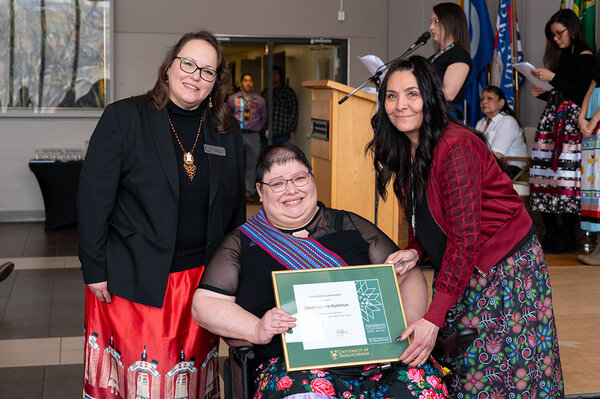
Healing lodges hold promise for female offenders
Psychology master’s student Amy Pilon has found that healing lodges are a more effective and humane way of rehabilitating women offenders
By Federica Giannelli
Andrea—not her real name—has lived a hard life. Physically abused as a child, she struggled with addictions for years and got into trouble with the law.
After spending some time in jail, she ended up in a healing lodge.
“Buffalo Sage Wellness House gave me support,” said the 31-year-old First Nations woman. “It taught me how to express my feelings and how to deal with people in the community.”
Now she is reintegrated into mainstream life with a job, friends and a dream to go to university one day.
Andrea is one of 40 women at Buffalo Sage Wellness House in Edmonton interviewed by University of Saskatchewan psychology master’s student Amy Pilon. The healing lodge is one of eight managed by Correctional Service Canada, and one of only two for women, the other being in Maple Creek, SK.
Healing lodges are minimum security institutions where people are offered a personalized rehabilitation program based on Aboriginal culture and spirituality. While receiving programming and training, they work with elders and the larger Aboriginal community.
Pilon wanted to learn how the facility and programs can be improved to help the women become more successful upon release.
Pilon, who has a Métis background herself, thinks healing lodges could change the way society rehabilitates women. Penitentiaries may not be the best way to reintegrate female Aboriginal offenders into society, she says.
“Healing lodges are less dehumanizing places than prisons,” said Pilon. “The women said it feels like family to be there.”
More than half the Aboriginal women in prisons usually return behind bars, but Pilon found that at Buffalo Sage, the recidivism rate is much lower.
Of the 40 women interviewed by Pilon who were released from Buffalo Sage since 2010, only 10 returned to custody and only one of them was re-arrested for new charges, she said. The others only committed minor violations, such as breaking curfew.
“We believe that their increased confidence is key for the women’s long-term success,” said Stephen Wormith, Pilon’s supervisor.
As well, it costs less than $90,000 a year to house a female offender in a healing lodge compared to the $211,618 per person spent for women in regular federal prisons, he said.
Lodges have been around since the 1990s, but little research has been done on their operation and success at rehabilitating offenders, particularly women.
Recent criminal justice research recommends that correctional programs and services consider the offenders’ personal and ethnic backgrounds in order to be most effective, said Wormith.
The number of Aboriginal women in Canadian prisons grew by a staggering 97 per cent from 2002 to 2012, according to a 2014 study from the federal justice department.
“Trying to solve this overrepresentation of Aboriginal peoples keeps me driving forward,” said Pilon. “Being Métis myself, I feel I can help.”
Correctional Service Canada, the federal research agency SSHRC, and the U of S Centre for Forensic Behavioural Science and Justice Studies provided funding for Pilon’s research.
Federica Giannelli is a graduate student intern in the U of S research profile and impact unit.
This article first ran as part of the 2015 Young Innovators series, an initiative of the U of S research profile office in partnership with the Saskatoon StarPhoenix.

